
WritingAIPaper
Writing AI Conference Papers: A Handbook for Beginners
Stars: 924
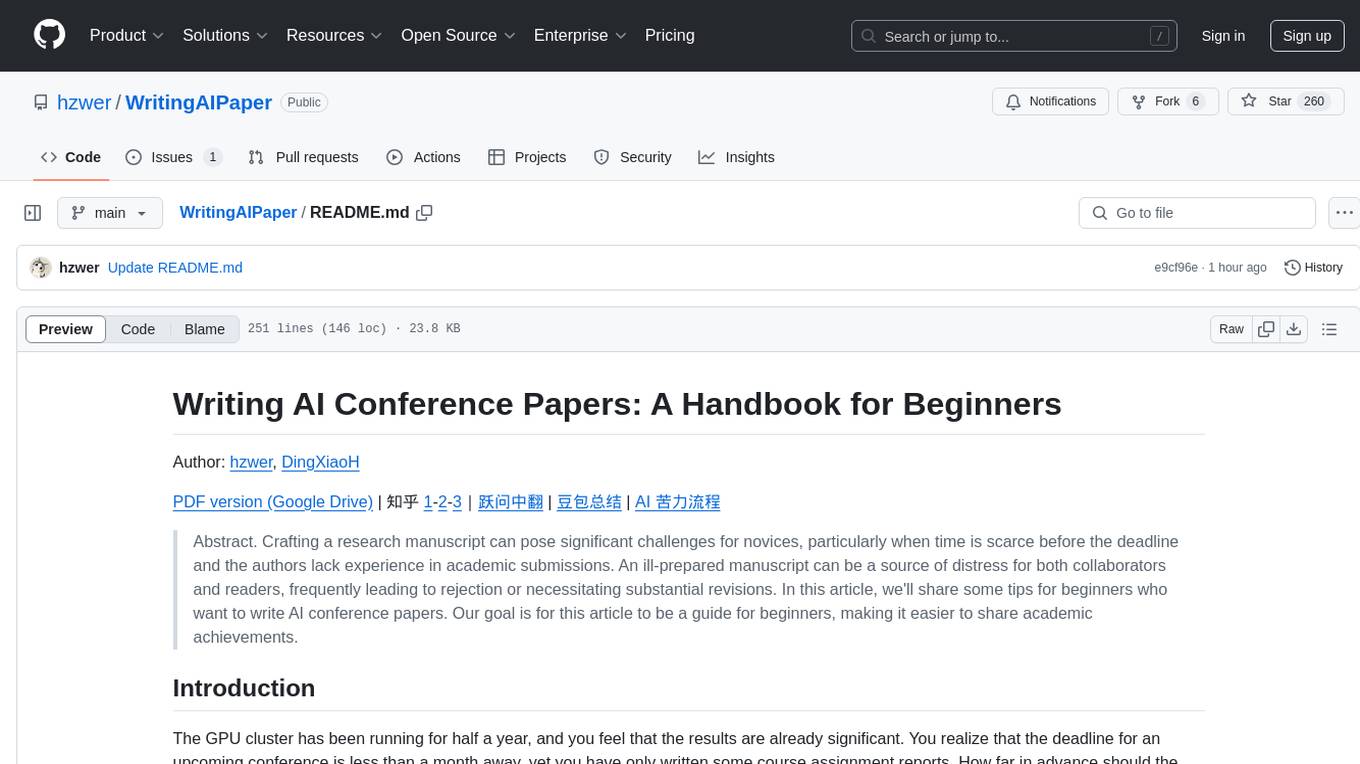
WritingAIPaper is a comprehensive guide for beginners on crafting AI conference papers. It covers topics like paper structure, core ideas, framework construction, result analysis, and introduction writing. The guide aims to help novices navigate the complexities of academic writing and contribute to the field with clarity and confidence. It also provides tips on readability improvement, logical strength, defensibility, confusion time reduction, and information density increase. The appendix includes sections on AI paper production, a checklist for final hours, common negative review comments, and advice on dealing with paper rejection.
README:
Abstract. Crafting a research manuscript can pose significant challenges for novices, particularly when time is scarce before the deadline and the authors lack experience in academic submissions. An ill-prepared manuscript can be a source of distress for both collaborators and readers, frequently leading to rejection or necessitating substantial revisions. In this article, we'll share some tips for beginners who want to write AI conference papers. Our goal is for this article to be a guide for beginners, making it easier to share academic achievements.
Background. The GPU cluster has been running for half a year, and you feel that the results are already significant. You realize that the deadline for an upcoming conference is less than a month away, yet you have only written some course assignment reports. How far in advance should the first draft be completed to avoid missing the deadline? What distinguishes a good research paper from a bad one? What should be done before starting to write? These questions plague you like a nightmare, leaving you staring at the blank Overleaf homepage. Luckily, this article is written for you.
In this article, we will discuss the aspects related to writing conference papers, with a focus on common pitfalls, catering to novices. Our article mainly consists of two parts: completing a paper and refining its details. We aim to provide practical guidance that will enable novices to navigate the complexities of academic writing and contribute to the field with clarity and confidence. Sincerely, we recommend the Resource List of Writing Tips curated by Chao Ma.
This section outlines writing an AI paper from scratch, covering structure, core idea, framework, results, and introduction.
Take-away: Abstract - Introduction - Main body, which are gradually unfolded. Each part is self-complete.
The typical structure of a paper includes 1. an abstract, 2. an introduction, and 3. the main body, which encompasses sections such as related work, methodology, experiments, discussion, conclusion, and references. We can break down this structure into three levels. At each level, you should aim to convey a comprehensive research narrative. Each level serves as an expansion of the preceding one. With this understanding, let's explore how to effectively present a research story. For those who are starting out, it's advisable to focus on completing the main body of the paper first.
You may have interesting findings and experimental results, but you're unsure how to define the core theme. The key contribution of most published papers falls into exactly one out of the following three categories (from Nowozion):
Insight: you have an explanation for something that is already there.
Performance: you can do something better.
Capability: you can do something that could not be done before.
Identify the core advantages of your work and emphasize them early in the paper. This way, readers can read the remaining parts with expectations. You can further expand the overall novelty from other aspects as well. Novelty seems to be elusive, what is it? Key research topics, efficient solutions, and innovative technical contributions are the primary elements that contribute to a paper's novelty. For instance, numerous early influential works of deep learning emerged from foundational model research due to their potential to impact the entire field. The RAFT/NeRF methods have attracted a large number of researchers due to their outstanding performance, and they involve a lot of engineering handling beyond their core ideas. Techniques such as "Batch Normalization" and "Residual Learning" are esteemed for their effectiveness. By emphasizing the novelty of your work, you'll be able to discern which aspects are worth the effort and which are inconsequential details.
A little squiggle of paint by Picasso can be as beautiful as an intricate painting by Rembrandt. —— Novelty in Science (highly recommended for readers)
Take-away: Clearly understand the increment over previous methods and find one or two core ideas.
When readers read papers, they seek novel insights. A good paper should have strong points that are easy to remember. You should refine your central ideas until you're confident that people will be eager to learn about them and share them widely. It is particularly worth noting that some ideas may be great, but if they lack originality, it may not be advisable to describe them in detail in the paper. When writing a paper, the focus should be on providing novel, unique, and valuable insights to attract readers' attention and inspire their interest.
Don't underestimate the novelty of your own work. Delve deep to uncover the underlying principles. If the ResNet paper were rewritten as: "We designed a model using a large number of $3\times3$ convolutions (inspired by VGGNet) and parallel shortcuts (simplified from GoogleNet) based on the former two", then it will also become a paper without novelty. The line of ResNet is to propose a problem, abstract the underlying principles, propose its own solutions and specific implementations, and verify them experimentally. This might not totally reflect their research process, but it effectively showcases their discoveries.
Take-away: Consider the target audience, introduce the valuable findings rather than the tortuous research process.
While adhering to the core ideas, start outlining the content you intend to present in your paper. Begin by creating a simple slide to demonstrate your research approach and achievements to your peers, colleagues, or mentors, in order to assess their understanding. It may be beneficial to intentionally seek feedback from researchers unfamiliar with your work to identify potential gaps in comprehension. Unlike the experimental process, it is advisable to emphasize valuable novelties and avoid presenting incomplete or complex aspects of your research. Researchers all understand the pain of research, but the bitter portrayal is only suitable for the postscript of the project. Continuously review and refine your presentation from the reader's perspective until it is easily understandable.
It may also be necessary to supplement your work with additional experiments if you feel that your experimental rationale lacks rigor. At the same time, it is advisable to conduct thorough literature research, ideally identifying several papers with highly relevant topics. Consider these as potential competitors to your paper and examine them for areas of improvement. Reflect on which aspects would captivate the community and accentuate them, while minimizing the inclusion of clichéd content.
Take-away: Around the contribution statements, conduct a solid analysis in the result section.
Many readers will initially assess the method's effectiveness by examining the results before deciding to read the entire paper. They'll look to see if your contribution aligns with the experimental findings. Even with strong confidence in your method's efficacy, you'll likely need additional comparative and ablation experiments. It's important to create more tables and visuals, selecting the most significant aspects to present. Honesty and objectivity are crucial; overstating claims is particularly undesirable. If concerned about overclaiming, discussing with peers is advisable.
With the above materials, you can start trying to write the introduction. Regarding the structure of the introduction, we directly quote from the textbook (from Elena):
Move 1. Establish a research territory
a. Show that the general research area is important, central, interesting, and problematic in some way;
Move 2. Find a niche
a. Indicate a gap in the previous research, or extend previous knowledge in some way.
Move 3. Occupy the niche
a. Outline purposes or state the nature of the present research;
b. List research questions or hypotheses;
c. Announce principle findings;
d. State the value of the present research;
e. Indicate the structure of the research paper.
Additional suggestions:
a. Knuth: Keep the reader upper-most in your mind;
b. Cut to the chase and don't write too much irrelevant to the paper's topic. The novel and interesting aspects of the paper should appear as early as possible;
c. Dedicate more space to describing original and novel ideas;
d. Respect the work of predecessors, and affirm historical contributions before pointing out shortcomings;
e. Consider using a "page one figure" to highlight the most important aspects of the paper and catch the reader's attention.
As we mentioned earlier, the main body is actually an extended version of the introduction. Typically, supplementing the introduction with additional experimental details forms the main body of the paper.
The part may not be included in the context of the introduction. A paper typically has a separate section dedicated to discussing related work, including some background work and competing work. Find three or four topics that are most relevant to your paper, and outline the historical evolution under each topic. Do not list all the negative aspects of other techniques, but rather explain how you improve upon them. You can first write a literature review that is independent of your work. You may classify and order the previous methods (for example, a certain method is a pioneer), and at this time, it is important to pay attention to the correct discussion. If you are not confident enough, check the "related work" sections of the papers you cited once more. Finally, rewrite this section from a more appropriate angle to reflect the unique aspects of your paper.
"Writing endures through the ages, its merits and faults known only to the author's heart. (文章千古事,得失寸心知)" —— Du Fu
"The best writing instruction ever: Good writing is bad writing rewritten. I got it from Stephen King. Where Stephen King got it, I don't know. I'm giving it to you. You tell your students." —— Robert Weiss
Take-away: The more prominent part, the more time you invest in it.
Next, we will mainly discuss the polishing of the details. At present, AI assistants like ChatGPT and Claude can easily help authors address the basic issues in English writing. We also recommend that authors in the Chinese region use 跃问 or 豆包. You can have the AI generate multiple versions and choose the most suitable one. When utilizing these tools, remember that prioritize clarity over style.
Let's move on to discuss the issues that are not easy to handle automatically. We will measure the readability of papers using the following concepts: logical strength, defensibility, confusion time, and information density. Based on these concepts, some practical suggestions and techniques are described to improve the readability.
Take-away: Do not misuse or abuse connectives.
In academic writing, logical coherence is more crucial than elegant vocabulary. Logical coherence is rooted in the logic itself, not in the connectives. We should view connectives as enhancements that smooth language, rather than using them to artificially construct sentence logic. Misalignment between connectives and actual logic can be confusing and greatly diminish readability. Here are a few specific examples:
We argue that problem A is critical. To this end, we propose method B.
"To this end" refers to which end? In fact, the previous context only presents a viewpoint without specifying any actions or goals, so the use of this connective is inherently incorrect. Connectives must be grammatically correct.
The system comprises three modules. First of all, Module A is .... Second, Module B is .... Last but not least, Module C is ....
Here, several connectives impose a certain order on these three things that originally have no order relationship. We should not use connectives to create logical relationships. It would be better to introduce the three modules separately.
When we write, we should think about how readers might find fault with every sentence we write. If they believe something that seems wrong, they might doubt the whole paper. To enhance the paper's trustworthiness, we need to minimize the likelihood of being challenged.
Take-away: Make statements based on references and facts.
When we write "Problem A is a pain point in this field and has not been solved yet," we should consider that the reader may ask, "Why is this a pain point? How serious are the consequences? Does this consequence have a significant impact on the final performance?" This requires the addition of appropriate references.
It is reported that problem A results in ... [1,2,3] and ... [4,5], which are critical to ... because ... [6, 7, 8].
When discussing the results of a paper, it is even more necessary to be rigorous:
The performance improves, which is attributed to the fact that XXX...
The evidence should be presented prominently;
The improvement may be explained by the fact that XXX...
Some indirect evidence such as visualizations can be shown.
Be as objective as possible and avoid exaggerating.
"Confusion time" is the sum of the time readers spend on each "hmm, what's this?" to "oh, I get it" moment during the reading process. The shorter the total confusion time of a paper, the higher the readability, and the more peaceful the reader will be.
Take-away: Explain a concept as close as possible when it is proposed.
It is recommended to directly explain the essence of a component after giving its name; for example, "We propose XXX, which is implemented with a two-layer multilayer perceptron (MLP)." If a concept is not easy to explain, it can be supplemented by referring to literature.
Take-away: Resolve relative pronoun ambiguity.
If it is not possible to make a long sentence completely unambiguous, it should be broken down into short sentences. A large proportion of the readership is not native speakers, and fancy sentence structures do not earn extra points.
Take-away: Frequently use topic sentences, preferably at the beginning of paragraphs.
The reader may not be able to quickly understand all the details, at which point the main information can be quickly obtained by the reader through the topic sentences, to avoid affecting the overall reading experience.
"Information density" refers to the efficiency with which text provides effective information to readers. Low information density may cause readers to lose focus and question the expertise.
Take-away: Get to the point as soon as possible.
The beginning of each section may talk about the history. Try not to be lengthy. "Do not write irrelevant content, nor should you write about things that most readers are already familiar with." Discussing the development of human writing skills, would certainly deter the vast majority of our readers.
Take-away: Both text and charts should be appropriately detailed or concise.
Use an appropriate layout that balances text and visuals. Avoid common pitfalls like featuring a large chart with only a few key points highlighted. Or a very long passage describing the experimental details and hyper-parameters, which should really be placed in the appendix.
Take-away: Important explanations and elucidations should be as close to the charts as possible.
The ideal situation is that each chart can be understood independently of the main text. In the caption, try to clearly state the theme and key conclusions. If there are abbreviations in the chart, it is best to have an explanation.
If you want to emphasize a certain result in Table 5, it is best for the sentence analyzing that result to be on the same page as Table 5, and it is best to have the words "Table 5" before and after that sentence. This is because readers may not carefully read the text you write, but first look at the charts and then look for text related to the content of the charts. When they see a striking result in Table 5 and become curious, they may use the search function in the PDF reader to search for "Table 5".
Do not expect readers to figure out for themselves from a complex table who should be compared with whom to draw conclusions. We should put the content we want to compare. If such a table is difficult to design, it is worth repeating a certain result (usually a baseline that needs to be compared with several groups of results) several times, even if it means sacrificing the elegance. No one will reject your paper because the tables are not elegant, but it is very annoying if the table is not clear.
First and foremost, avoid making mistakes. Prioritize the rigor of the paper before considering its aesthetics. The following is a checklist that can help authors improve their writing:
- [ ] Go through the charts to ensure the story is complete. Strive to improve the quality of the charts and make them self-explanatory.
- [ ] Check for any inconsistencies in symbols, abbreviations, and references.
- [ ] Whether the level of detail in the text and charts is appropriate?
- [ ] Place important information in prominent positions.
- [ ] Can the text and legends in the figure be larger?
- [ ] Can the understanding speed of tables be improved by using methods such as column division, bolding text, and deleting redundancy?
We will list more minor items in the Appendix.
Take-away: Good luck!
As this manuscript stands without the benefit of peer review, it undoubtedly contains numerous imperfections. The concepts presented herein are primarily derived from widely shared community knowledge, which we have endeavored to synthesize and simplify for the benefit of newcomers to the community. Our goal is to provide a concise yet comprehensive guide that can ease the learning curve for those embarking on the journey of writing AI conference papers. If this document serves as a beacon of clarity and direction for any reader, we would consider our efforts successful. Leaving a star will be a great encouragement to us.
In the Appendix, several topics are covered:
Checklist for Last Few Hours: It provides a checklist to ensure the paper is in order before submission.
AI Paper Production and Publication: It outlines the process of paper submission, review, and publication in AI conferences.
Common Negative Review Comments: It lists common criticisms reviewers might have and suggestions for revision.
If the Paper Is Not Accepted: It offers advice on dealing with rejection and improving the paper for future submissions.
- [ ] Check that various numbers are not copied incorrectly.
- [ ] Search for question marks to check for latex errors.
- [ ] Make sure that all charts are mentioned in the main text and that the order of mentions matches the order in which the charts appear.
- [ ] The caption is very noticeable. Avoid grammatical errors, and it is recommended to use a period.
- [ ] Vectorize the charts.
- [ ] Check that all formulas are complete, they are easily overlooked in the editing process.
- [ ] Go through all the subtitles and unify the capitalization style.
- [ ] Confirm that there are no figures outside the main body pages.
- [ ] Check for anonymity; you may need to delete acknowledgments.
- [ ] Ensure the number of pages is correct to avoid being desk rejected.
This section mainly introduces the process of producing papers and the review process. A conference paper usually runs about eight pages in a two-column layout, or over ten pages in a single-column layout, based on the conference's specifications. Authors prepare and submit their paper along with supplementary materials like code and demo videos by the given deadline.
Provided there are no critical oversights, such as neglecting to anonymize the submission, substantial formatting issues, or surpassing the page limit — any of which could result in an immediate rejection (known as a "desk reject") — the paper proceeds to the review phase. Following approximately two months, authors receive feedback from typically three reviewers in the form of comments and an overall score for their paper. Many of these reviewers have published work in related domains and might be cited in the submitted paper. With the initial review outcomes, authors must craft a brief rebuttal, generally one page, to address queries or provide additional findings. Roughly half of the papers are withdrawn during this rebuttal phase. Reviewers then deliberate for a week or two (commonly on a private platform) based on the rebuttal, indicating whether their concerns have been alleviated and discussing the paper's merits. Usually, reviewers align on a positive or negative stance, though occasionally, the area chair decides.
The final acceptance outcome necessitates waiting for approximately another month, after which it will be revealed via the email system. Typically, acceptance rates range from one-sixth to one-quarter of submitted manuscripts. Authors then revise their work based on reviewer feedback before submitting the final, camera-ready version for publication. The majority of papers, however, face rejection and are returned to the authors. These authors may opt to resubmit following the previously mentioned process or decide to discontinue work on the paper. It is worth noting that most papers undergo an extensive period of refinement and revision, colloquially dubbed the "Fibonacci Submission Approach." (Recommendation: a Chinese lecture by Boxin Shi).
We have listed some common negative reviews and suggested revisions (in italics).
- Criticizing the author for being unprofessional: Important references are missing; the paper structure is messy, and some essential elements are lacking, such as not submitting supplementary video results for a video-related study; the experimental setup is significantly different from previous work.
Refer to the reference list of recent papers to fill in the gaps, and the configuration should be aligned.
- Questioning the validity: The reported results do not conform to common sense and are not credible; exaggerating one's own achievements or making some obviously incorrect assertions; there are flaws in the experimental setup or argumentation.
Conduct more experiments, refine the expression, and strive for rigor.
- Not respecting previous work: Not citing the latest results, conducting low-benchmark experiments; excessively demeaning the work of predecessors; confusing one's own work with the contributions of predecessors.
Compare more with existing work tables, conduct more paper research, and if you say others have done a poor job, provide evidence.
- Lack of novelty: The story is not well written, the logic is not clear, or most of it is known knowledge; feeling that the work is incremental and does not contribute much. In other words, the effect is not impressive.
Discuss with some peers, and highlight the strengths.
- Poor paper presentation quality: Many grammatical errors, poor writing, poor English level; difficult to understand, lacking some details.
Use AI tools or Grammarly to revise, and ask friends for help to read.
- Disagreement on the approach: Not approving of the experimental design or not believing in this technical route.
Conduct more experiments or cite similar expressions in relevant literature to support your argument, and try to win over other reviewers.
Review process is highly random. But there is one golden rule that withstands the test of time and randomness - badly written papers get bad reviews. Period. It doesn’t matter if the idea is good, result is good, citations are good. Not at all. Writing is critical — and this is ironic because engineers are the worst-trained writers among all disciplines in a university. You need to discipline yourself: leave time for writing, think deeply about writing, and write it over and over again till it’s as polished as you can think of. (Fei-Fei Li)
There are many papers that stayed on arXiv after being rejected and now have a huge impact 1;2;3;4. Many great works have been rejected and even got extremely negative comments. The paper is merely the beginning or footnote of the work. The review process is especially painful for novices, who may be putting all their eggs in one basket. The paper will be significantly improved throughout the process. If this process helps you produce a truly good paper, you can benefit from and be proud of it for many years to come.
ArXiv does not accept this article 😂. In case you need to cite it, you can use the following format.
@misc{WritingAIPaper2024,
author = {Zhewei Huang and Xiaohan Ding},
title = {Writing AI Conference Papers: A Handbook for Beginners},
publisher = {GitHub},
journal = {GitHub repository},
howpublished = {\url{https://github.com/hzwer/WritingAIPaper}},
year = {2024},
month = {9},
}
For Tasks:
Click tags to check more tools for each tasksFor Jobs:
Alternative AI tools for WritingAIPaper
Similar Open Source Tools

WritingAIPaper
WritingAIPaper is a comprehensive guide for beginners on crafting AI conference papers. It covers topics like paper structure, core ideas, framework construction, result analysis, and introduction writing. The guide aims to help novices navigate the complexities of academic writing and contribute to the field with clarity and confidence. It also provides tips on readability improvement, logical strength, defensibility, confusion time reduction, and information density increase. The appendix includes sections on AI paper production, a checklist for final hours, common negative review comments, and advice on dealing with paper rejection.
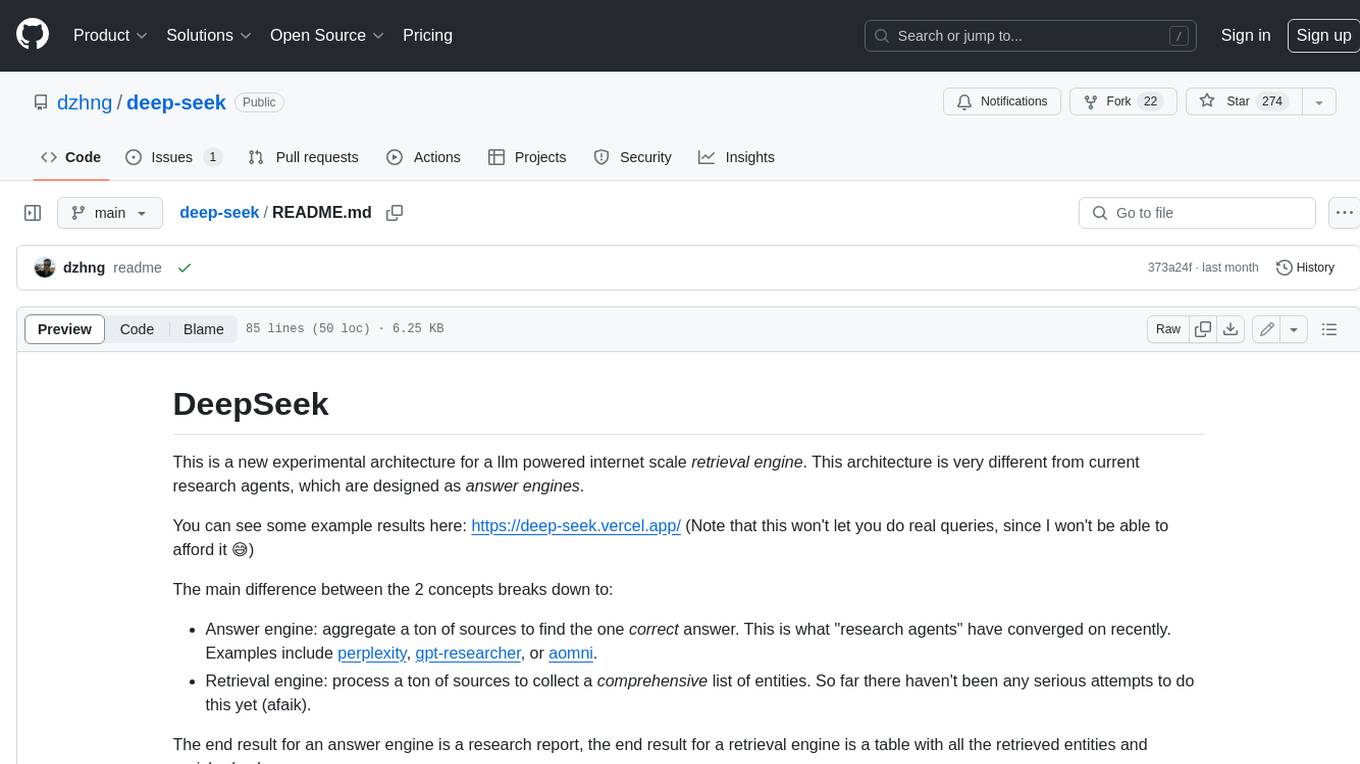
deep-seek
DeepSeek is a new experimental architecture for a large language model (LLM) powered internet-scale retrieval engine. Unlike current research agents designed as answer engines, DeepSeek aims to process a vast amount of sources to collect a comprehensive list of entities and enrich them with additional relevant data. The end result is a table with retrieved entities and enriched columns, providing a comprehensive overview of the topic. DeepSeek utilizes both standard keyword search and neural search to find relevant content, and employs an LLM to extract specific entities and their associated contents. It also includes a smaller answer agent to enrich the retrieved data, ensuring thoroughness. DeepSeek has the potential to revolutionize research and information gathering by providing a comprehensive and structured way to access information from the vastness of the internet.
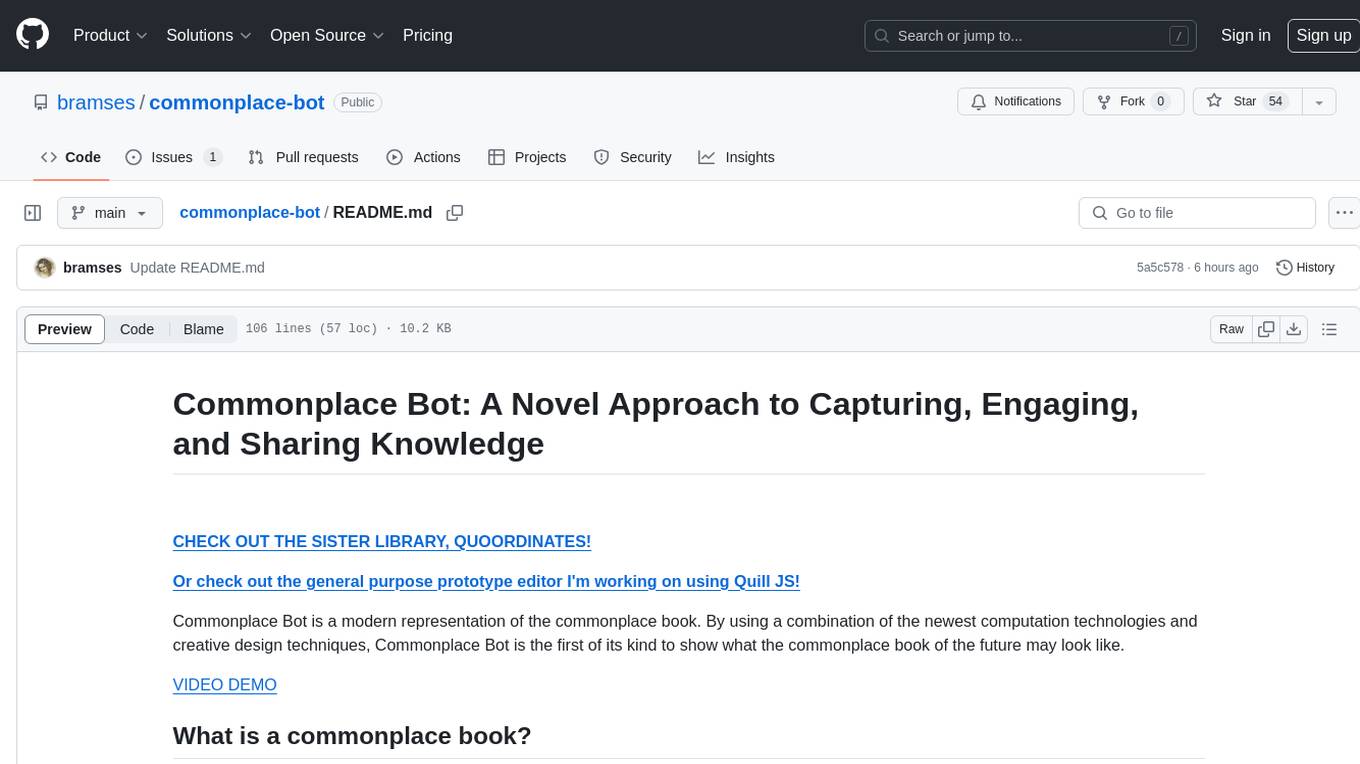
commonplace-bot
Commonplace Bot is a modern representation of the commonplace book, leveraging modern technological advancements in computation, data storage, machine learning, and networking. It aims to capture, engage, and share knowledge by providing a platform for users to collect ideas, quotes, and information, organize them efficiently, engage with the data through various strategies and triggers, and transform the data into new mediums for sharing. The tool utilizes embeddings and cached transformations for efficient data storage and retrieval, flips traditional engagement rules by engaging with the user, and enables users to alchemize raw data into new forms like art prompts. Commonplace Bot offers a unique approach to knowledge management and creative expression.
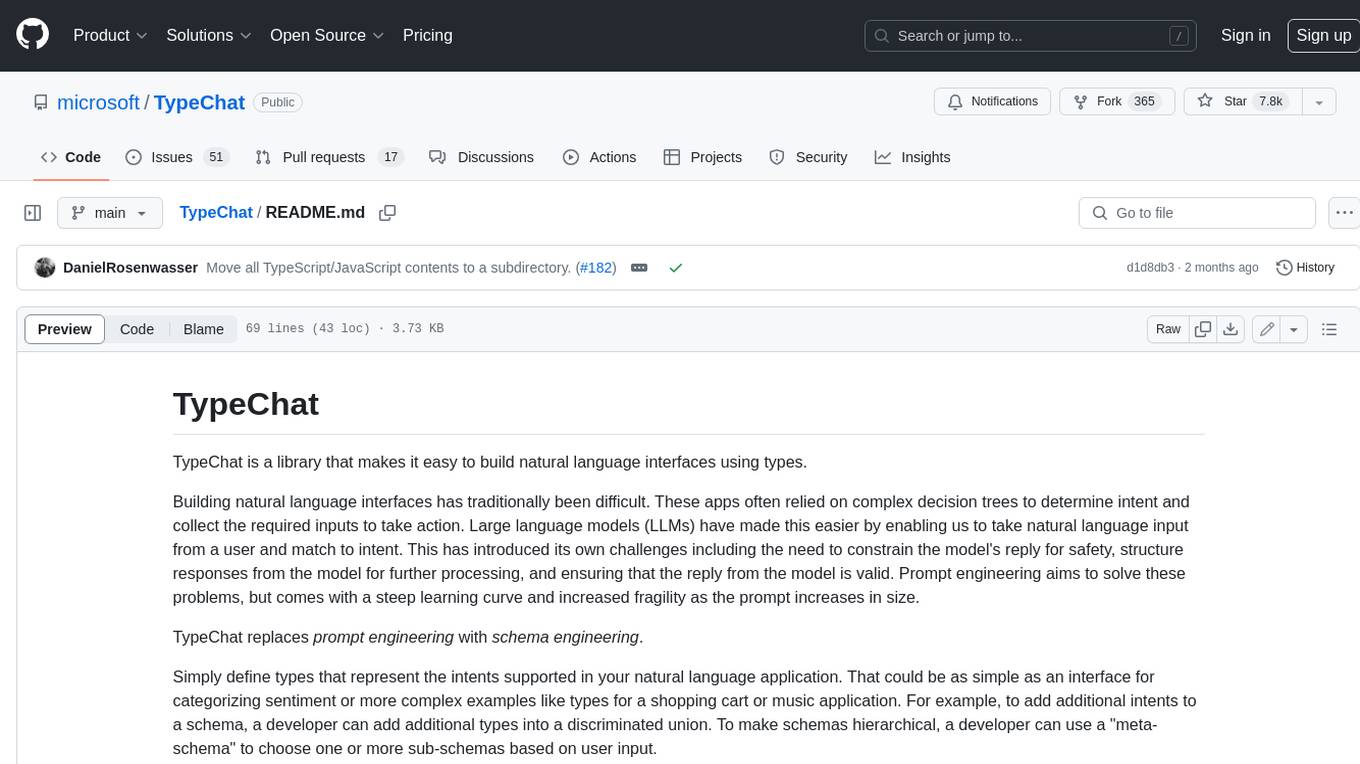
TypeChat
TypeChat is a library that simplifies the creation of natural language interfaces using types. Traditionally, building natural language interfaces has been challenging, often relying on complex decision trees to determine intent and gather necessary inputs for action. Large language models (LLMs) have simplified this process by allowing us to accept natural language input from users and match it to intent. However, this has introduced new challenges, such as the need to constrain the model's response for safety, structure responses from the model for further processing, and ensure the validity of the model's response. Prompt engineering aims to address these issues, but it comes with a steep learning curve and increased fragility as the prompt grows in size.
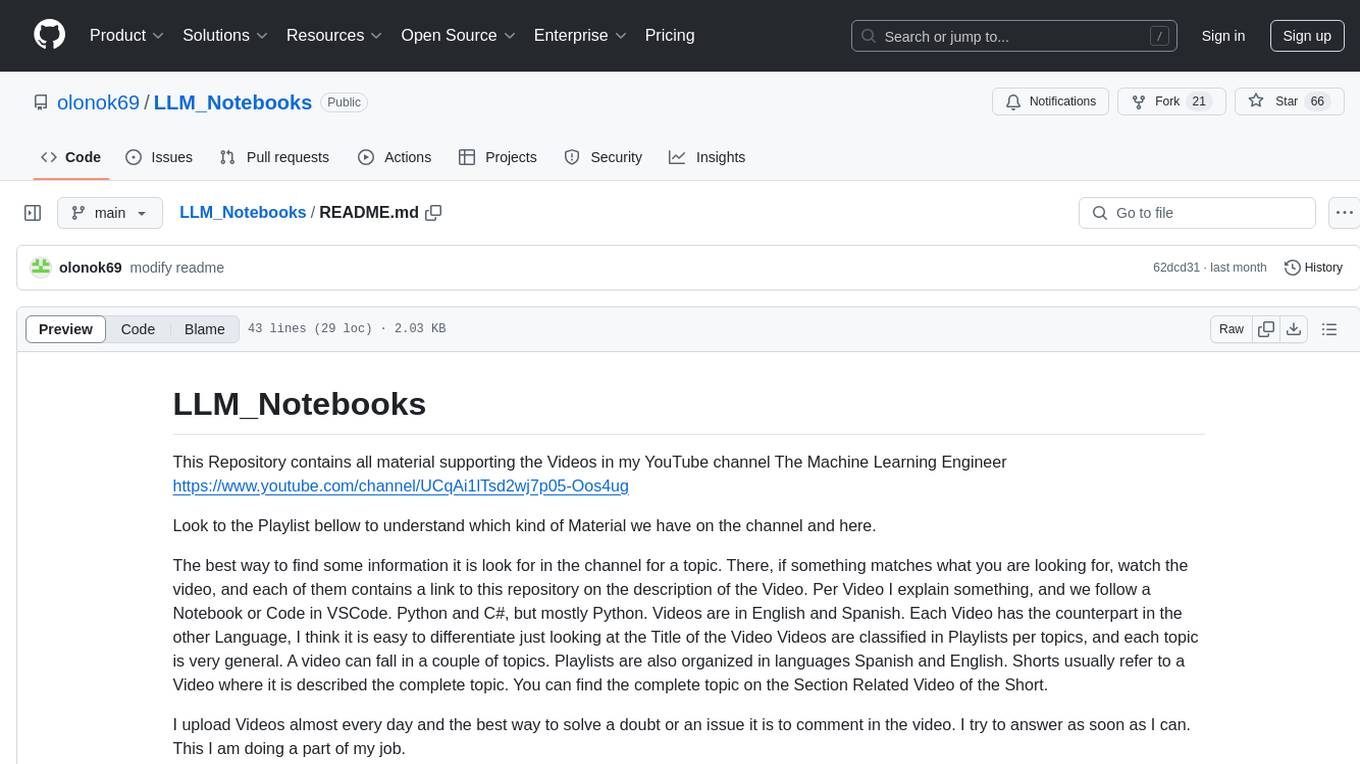
LLM_Notebooks
LLM_Notebooks is a repository supporting The Machine Learning Engineer YouTube channel. It contains materials related to various topics such as Generative AI, MLOps, ML projects, Azure Projects, Google VertexAi, ML Tricks, and more. The repository includes notebooks and code in Python and C#, with a focus on Python. The videos on the channel cover a wide range of topics in English and Spanish, organized into playlists based on general themes. The repository links are provided in the video descriptions for easy access. The creator uploads videos regularly and encourages viewers to subscribe, like, and leave constructive comments. The repository serves as a valuable resource for learning and exploring machine learning concepts and tools.
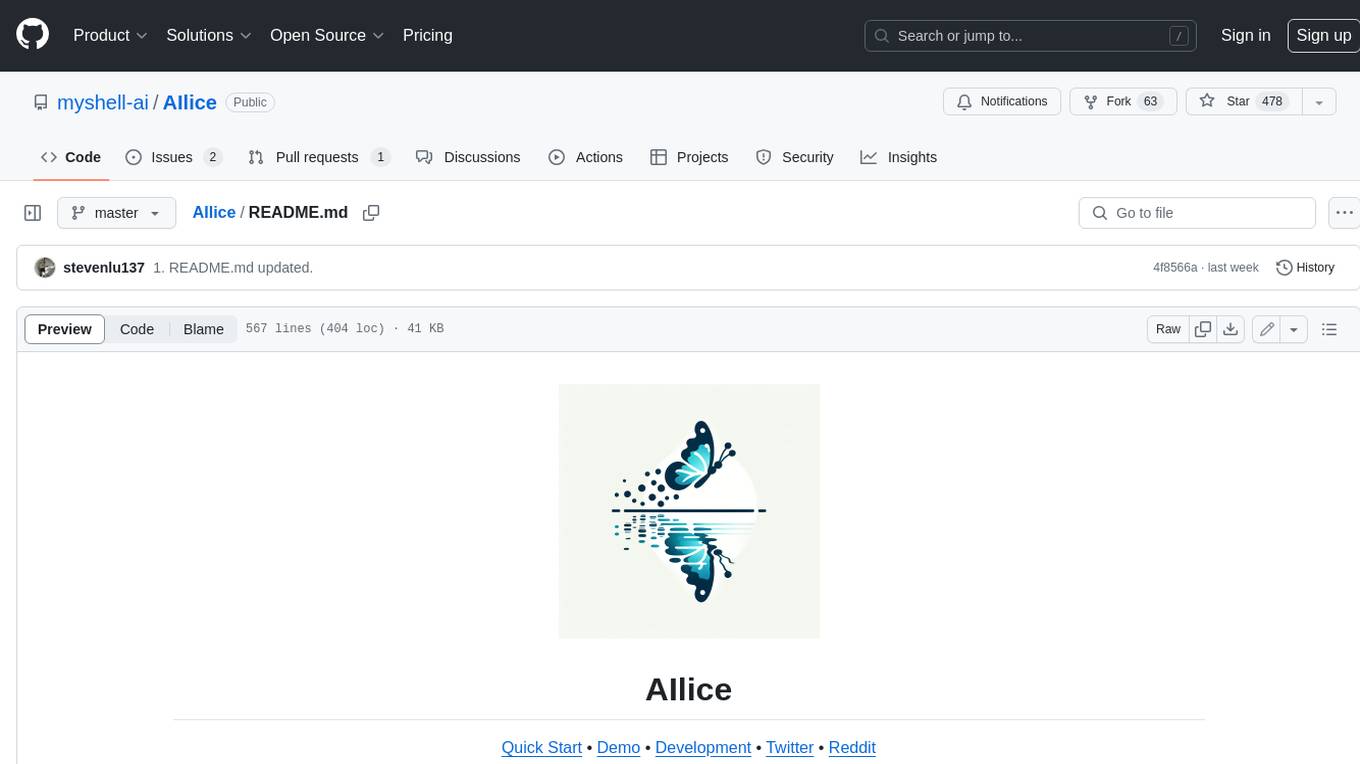
AIlice
AIlice is a fully autonomous, general-purpose AI agent that aims to create a standalone artificial intelligence assistant, similar to JARVIS, based on the open-source LLM. AIlice achieves this goal by building a "text computer" that uses a Large Language Model (LLM) as its core processor. Currently, AIlice demonstrates proficiency in a range of tasks, including thematic research, coding, system management, literature reviews, and complex hybrid tasks that go beyond these basic capabilities. AIlice has reached near-perfect performance in everyday tasks using GPT-4 and is making strides towards practical application with the latest open-source models. We will ultimately achieve self-evolution of AI agents. That is, AI agents will autonomously build their own feature expansions and new types of agents, unleashing LLM's knowledge and reasoning capabilities into the real world seamlessly.
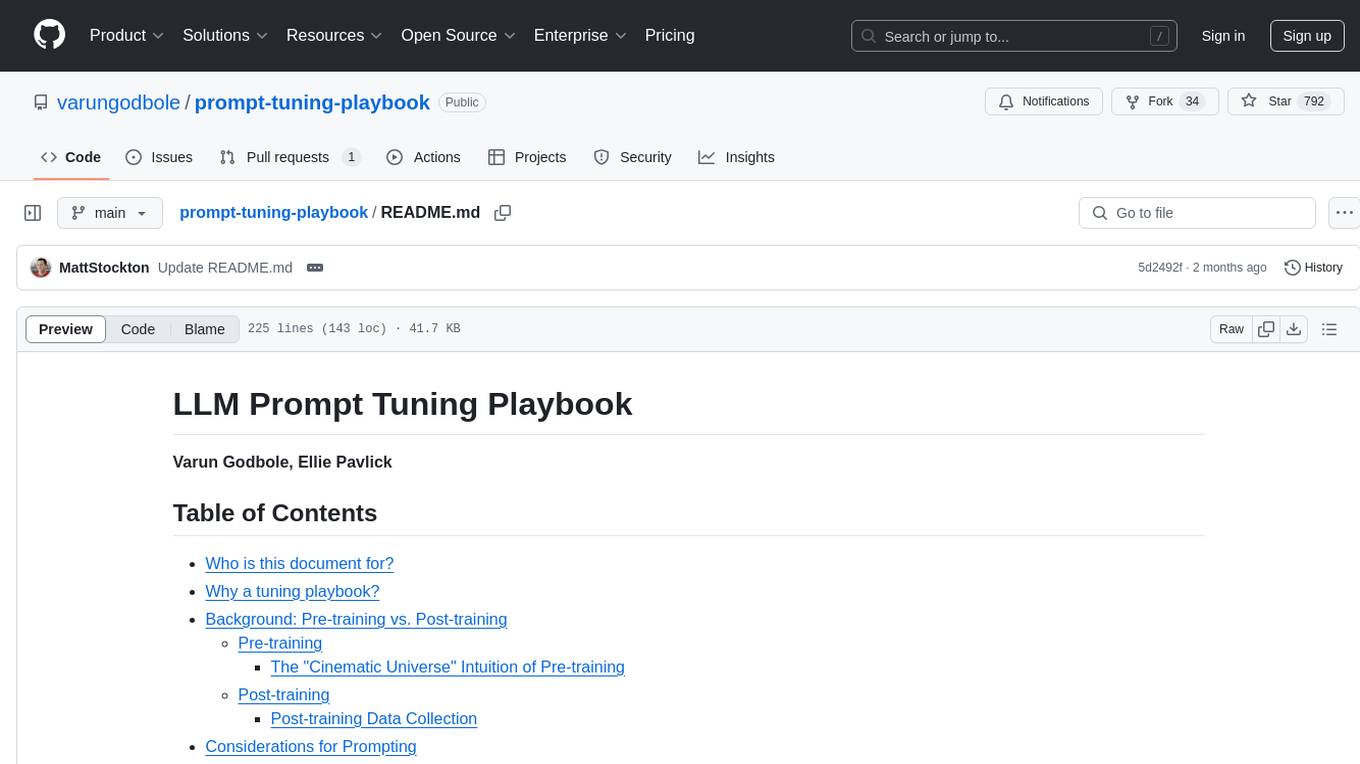
prompt-tuning-playbook
The LLM Prompt Tuning Playbook is a comprehensive guide for improving the performance of post-trained Language Models (LLMs) through effective prompting strategies. It covers topics such as pre-training vs. post-training, considerations for prompting, a rudimentary style guide for prompts, and a procedure for iterating on new system instructions. The playbook emphasizes the importance of clear, concise, and explicit instructions to guide LLMs in generating desired outputs. It also highlights the iterative nature of prompt development and the need for systematic evaluation of model responses.
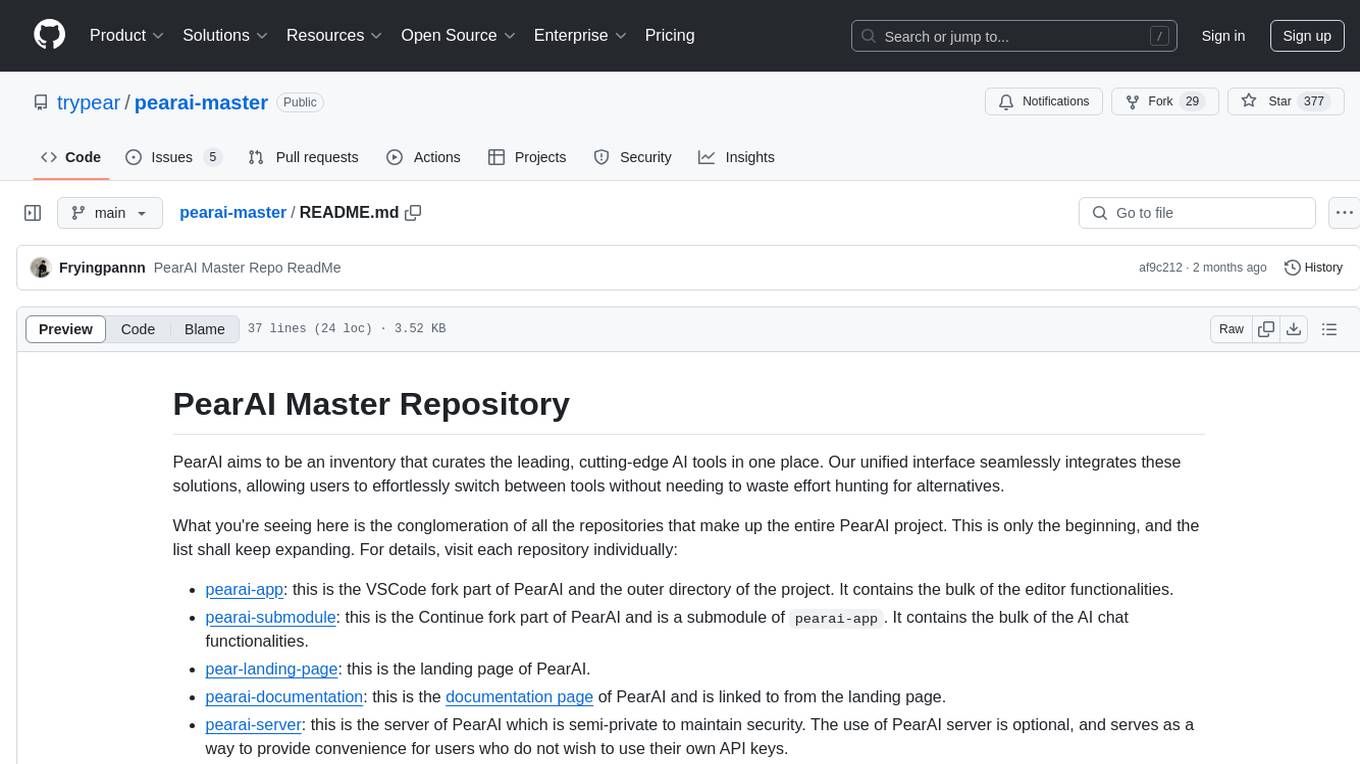
pearai-master
PearAI is an inventory that curates cutting-edge AI tools in one place, offering a unified interface for seamless tool integration. The repository serves as the conglomeration of all PearAI project repositories, including VSCode fork, AI chat functionalities, landing page, documentation, and server. Contributions are welcome through quests and issue tackling, with the project stack including TypeScript/Electron.js, Next.js/React, Python FastAPI, and Axiom for logging/telemetry.
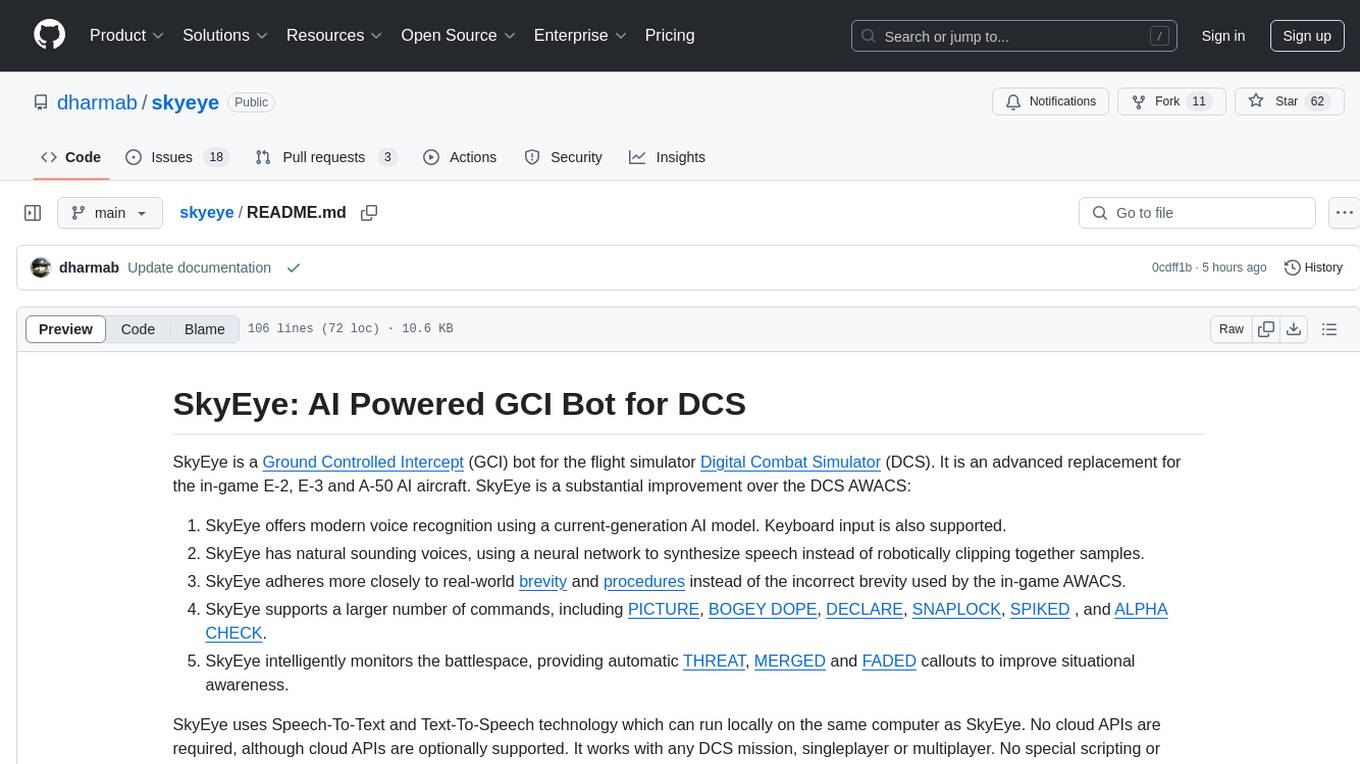
skyeye
SkyEye is an AI-powered Ground Controlled Intercept (GCI) bot designed for the flight simulator Digital Combat Simulator (DCS). It serves as an advanced replacement for the in-game E-2, E-3, and A-50 AI aircraft, offering modern voice recognition, natural-sounding voices, real-world brevity and procedures, a wide range of commands, and intelligent battlespace monitoring. The tool uses Speech-To-Text and Text-To-Speech technology, can run locally or on a cloud server, and is production-ready software used by various DCS communities.
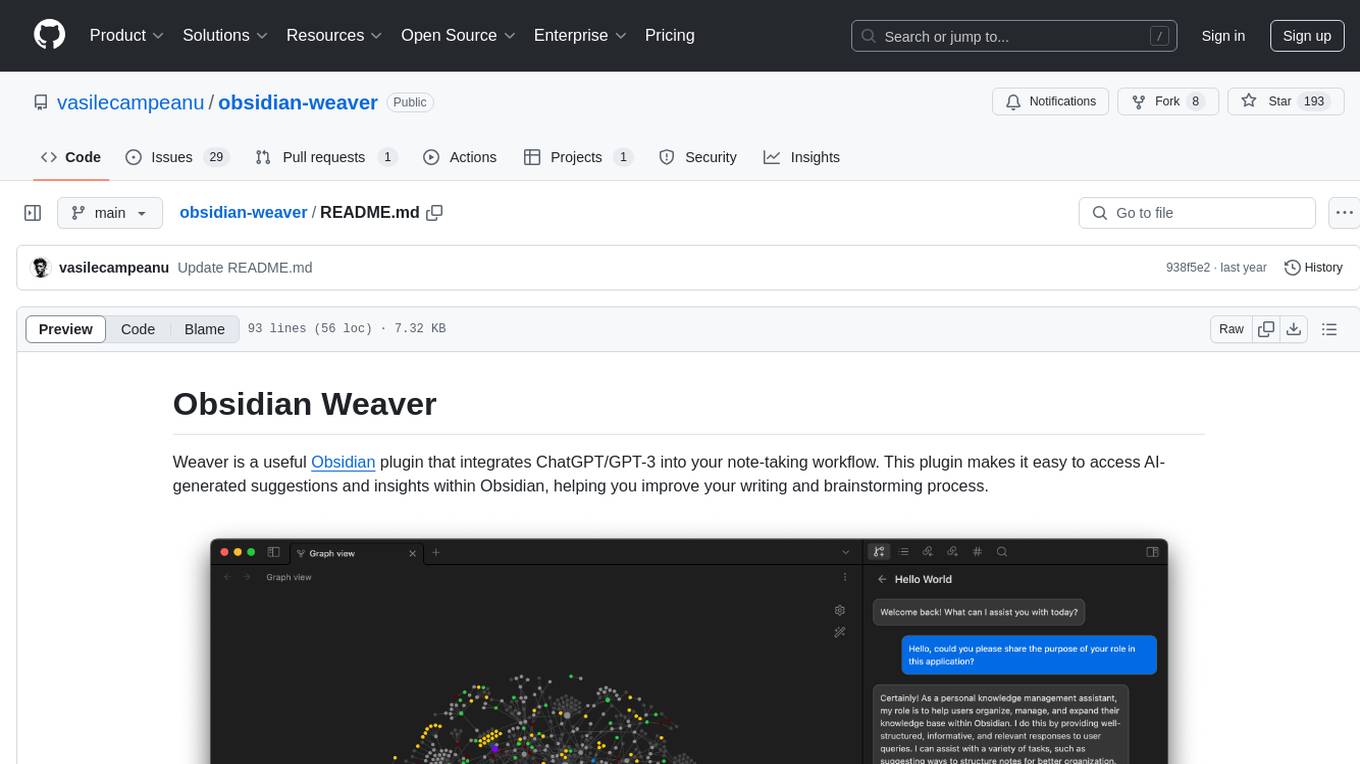
obsidian-weaver
Obsidian Weaver is a plugin that integrates ChatGPT/GPT-3 into the note-taking workflow of Obsidian. It allows users to easily access AI-generated suggestions and insights within Obsidian, enhancing the writing and brainstorming process. The plugin respects Obsidian's philosophy of storing notes locally, ensuring data security and privacy. Weaver offers features like creating new chat sessions with the AI assistant and receiving instant responses, all within the Obsidian environment. It provides a seamless integration with Obsidian's interface, making the writing process efficient and helping users stay focused. The plugin is constantly being improved with new features and updates to enhance the note-taking experience.
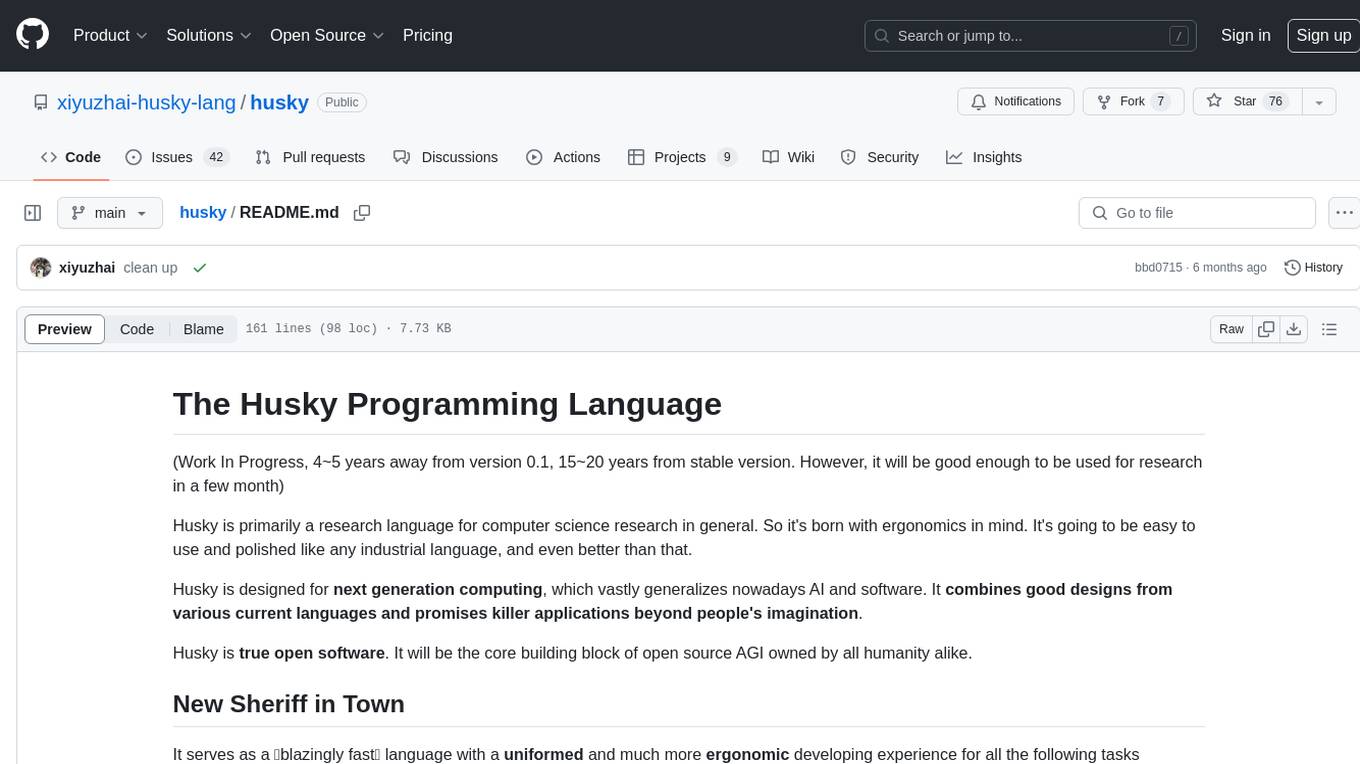
husky
Husky is a research-focused programming language designed for next-generation computing. It aims to provide a powerful and ergonomic development experience for various tasks, including system level programming, web/native frontend development, parser/compiler tasks, game development, formal verification, machine learning, and more. With a strong type system and support for human-in-the-loop programming, Husky enables users to tackle complex tasks such as explainable image classification, natural language processing, and reinforcement learning. The language prioritizes debugging, visualization, and human-computer interaction, offering agile compilation and evaluation, multiparadigm support, and a commitment to a good ecosystem.

AnkiGPT
AnkiGPT is a tool that leverages GPT-3.5 or GPT-4 by OpenAI to generate flashcards from lecture slides or text input. Users can easily export the generated flashcards to Anki for effective learning. The tool allows users to edit, delete, and share flashcards, as well as generate mnemonics. AnkiGPT supports nearly all languages and ensures user privacy by not using submitted content for AI training. While powerful, the tool has limitations such as occasional errors in generated flashcards and challenges with mathematical equations. AnkiGPT is designed specifically for Anki flashcard app integration and encourages users to review and verify flashcard information for accuracy.
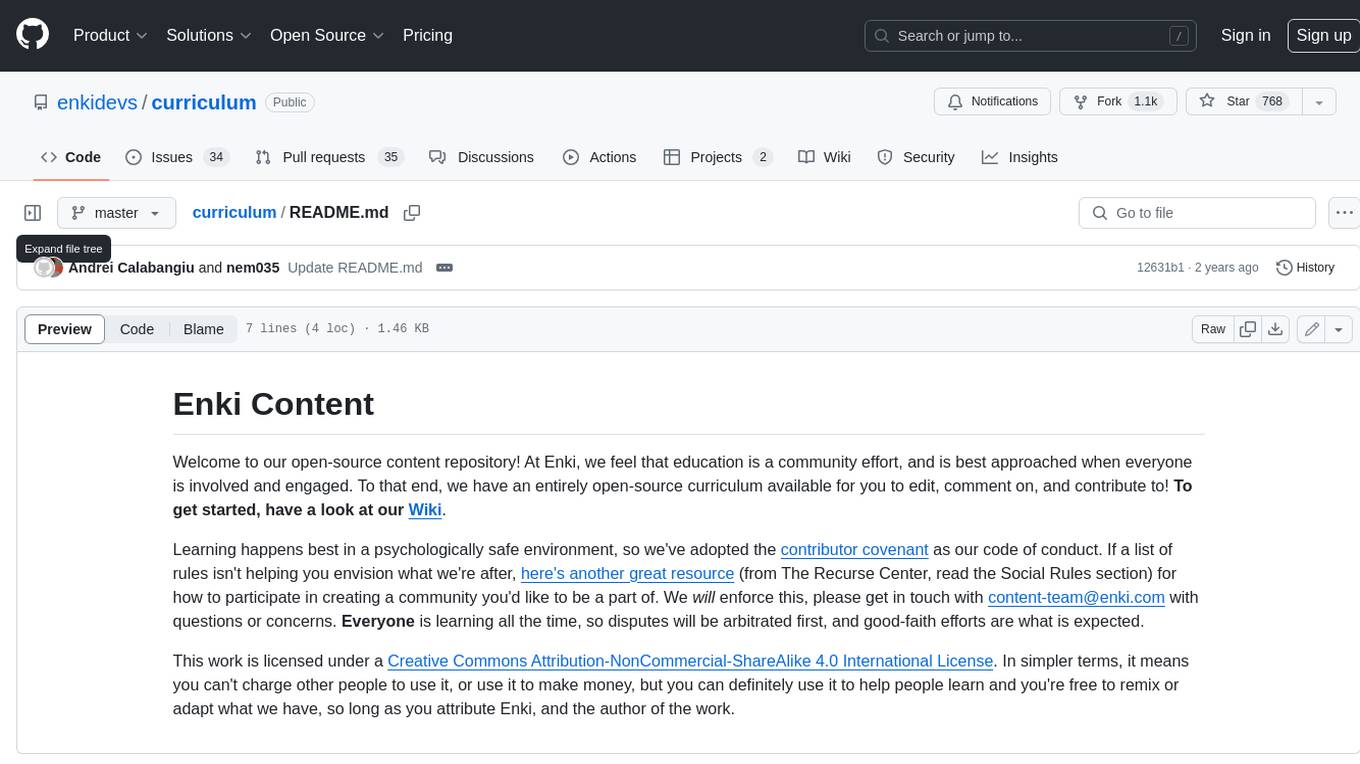
curriculum
The 'curriculum' repository is an open-source content repository by Enki, providing a community-driven curriculum for education. It follows a contributor covenant code of conduct to ensure a safe and engaging learning environment. The content is licensed under Creative Commons, allowing free use for non-commercial purposes with attribution to Enki and the author.
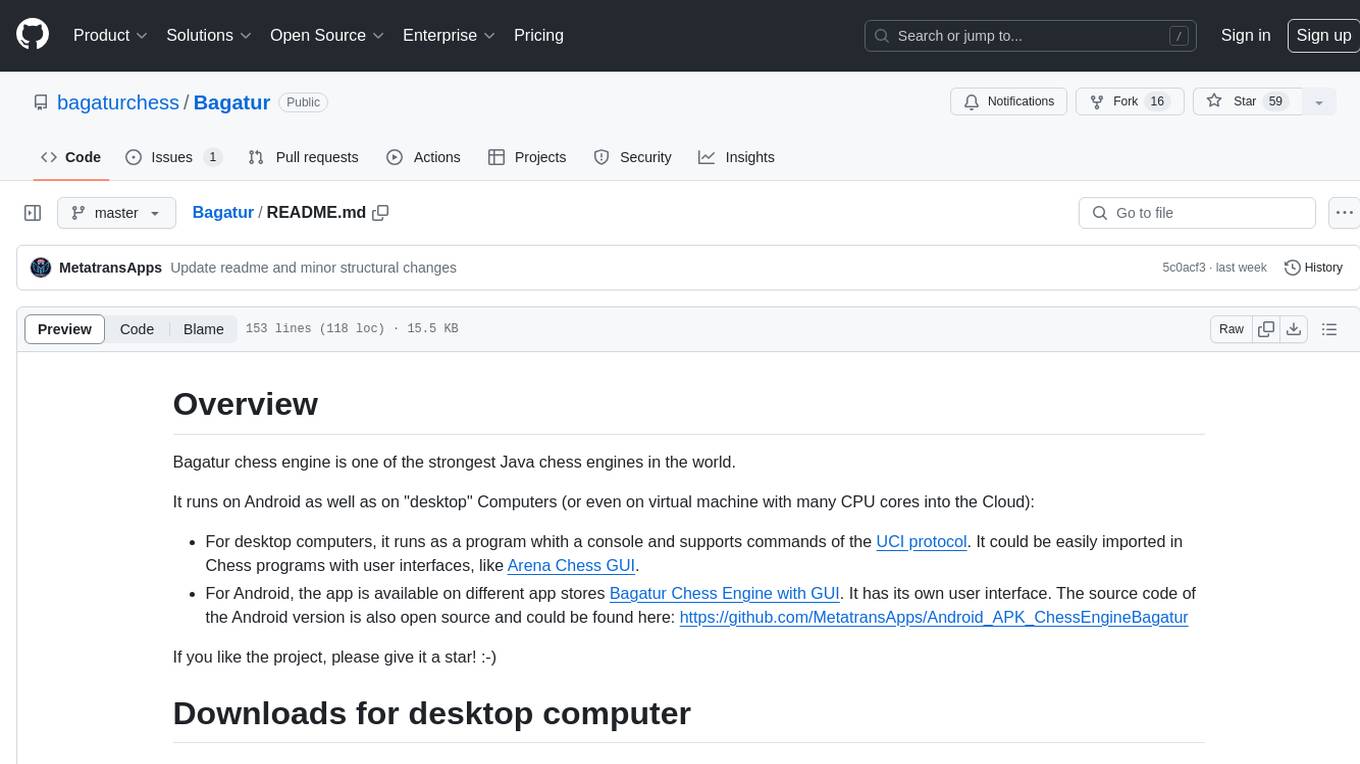
Bagatur
Bagatur chess engine is a powerful Java chess engine that can run on Android devices and desktop computers. It supports the UCI protocol and can be easily integrated into chess programs with user interfaces. The engine is available for download on various platforms and has advanced features like SMP (multicore) support and NNUE evaluation function. Bagatur also includes syzygy endgame tablebases and offers various UCI options for customization. The project started as a personal challenge to create a chess program that could defeat a friend, leading to years of development and improvements.
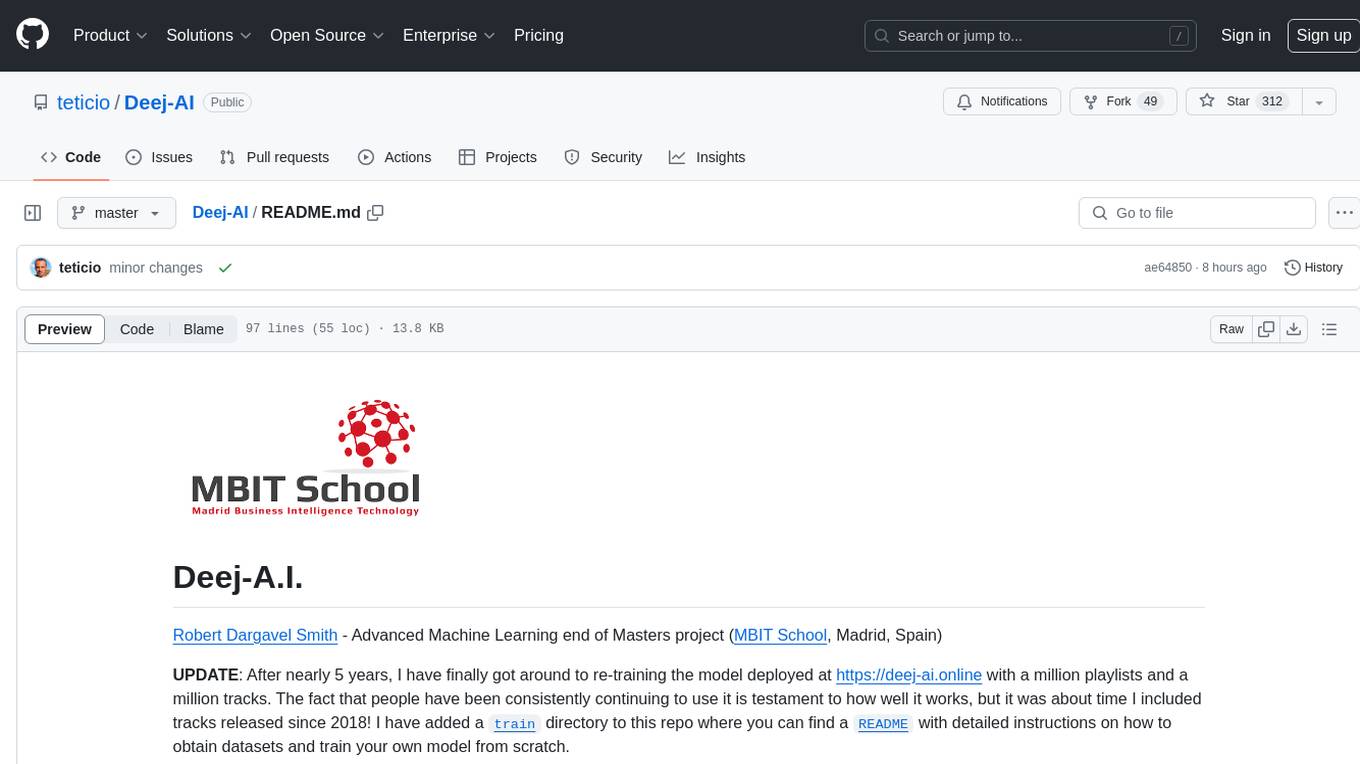
Deej-AI
Deej-A.I. is an advanced machine learning project that aims to revolutionize music recommendation systems by using artificial intelligence to analyze and recommend songs based on their content and characteristics. The project involves scraping playlists from Spotify, creating embeddings of songs, training neural networks to analyze spectrograms, and generating recommendations based on similarities in music features. Deej-A.I. offers a unique approach to music curation, focusing on the 'what' rather than the 'how' of DJing, and providing users with personalized and creative music suggestions.
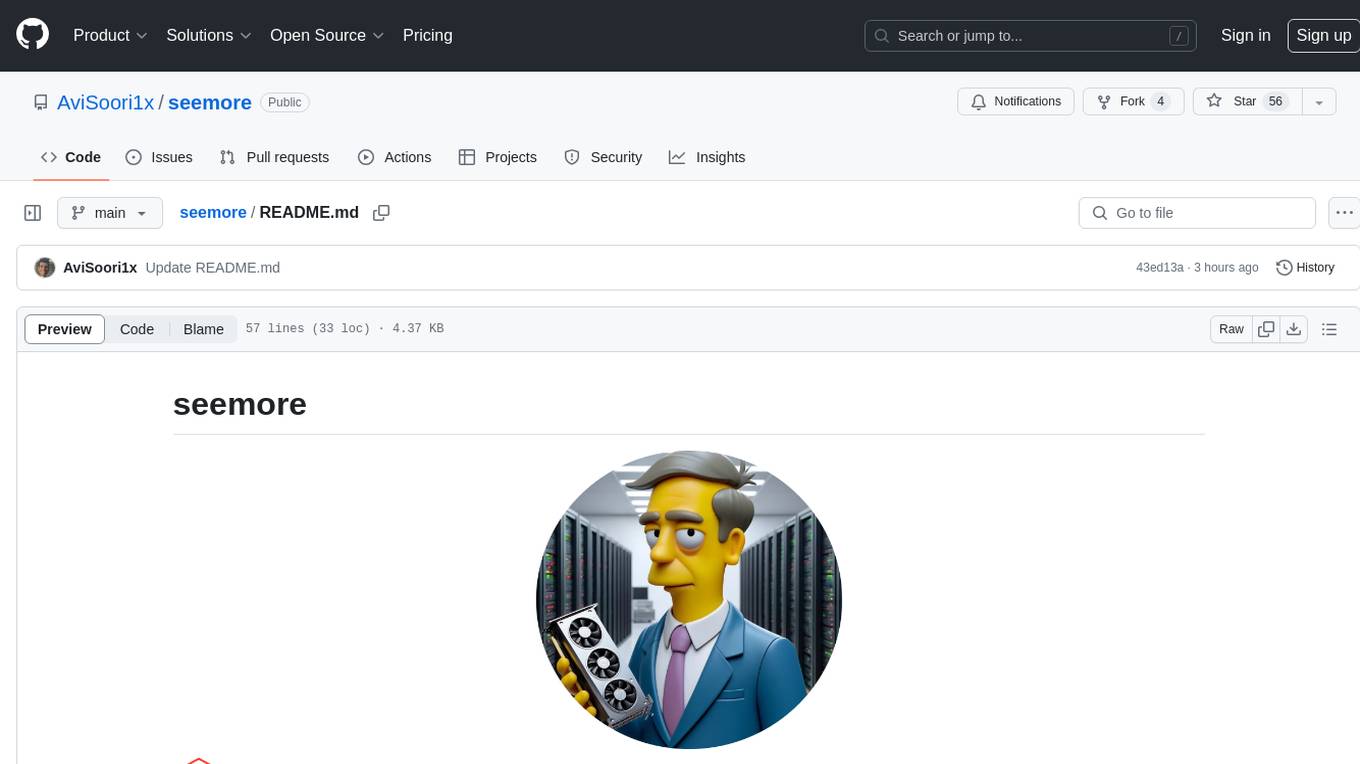
seemore
seemore is a vision language model developed in Pytorch, implementing components like image encoder, vision-language projector, and decoder language model. The model is built from scratch, including attention mechanisms and patch creation. It is designed for readability and hackability, with the intention to be improved upon. The implementation is based on public publications and borrows attention mechanism from makemore by Andrej Kapathy. The code was developed on Databricks using a single A100 for compute, and MLFlow is used for tracking metrics. The tool aims to provide a simplistic version of vision language models like Grok 1.5/GPT-4 Vision, suitable for experimentation and learning.
For similar tasks

WritingAIPaper
WritingAIPaper is a comprehensive guide for beginners on crafting AI conference papers. It covers topics like paper structure, core ideas, framework construction, result analysis, and introduction writing. The guide aims to help novices navigate the complexities of academic writing and contribute to the field with clarity and confidence. It also provides tips on readability improvement, logical strength, defensibility, confusion time reduction, and information density increase. The appendix includes sections on AI paper production, a checklist for final hours, common negative review comments, and advice on dealing with paper rejection.
For similar jobs
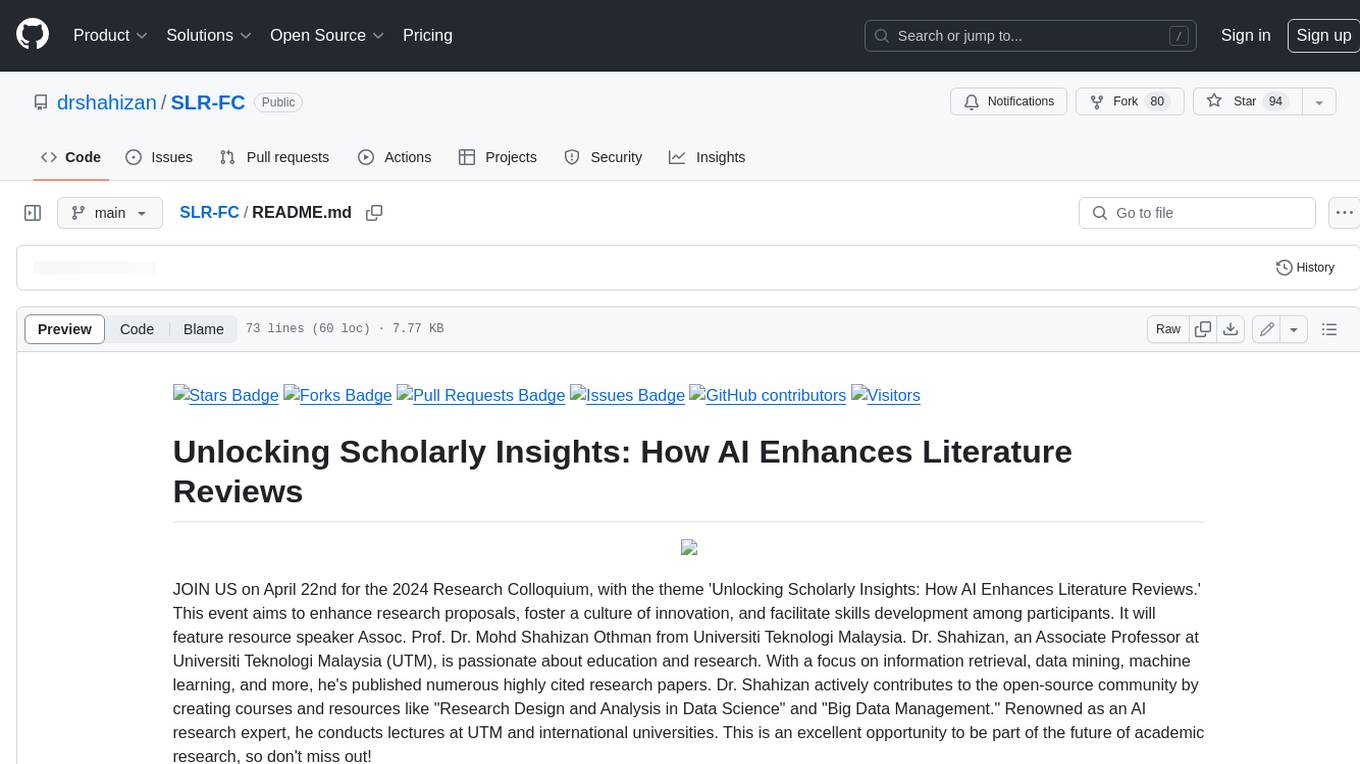
SLR-FC
This repository provides a comprehensive collection of AI tools and resources to enhance literature reviews. It includes a curated list of AI tools for various tasks, such as identifying research gaps, discovering relevant papers, visualizing paper content, and summarizing text. Additionally, the repository offers materials on generative AI, effective prompts, copywriting, image creation, and showcases of AI capabilities. By leveraging these tools and resources, researchers can streamline their literature review process, gain deeper insights from scholarly literature, and improve the quality of their research outputs.
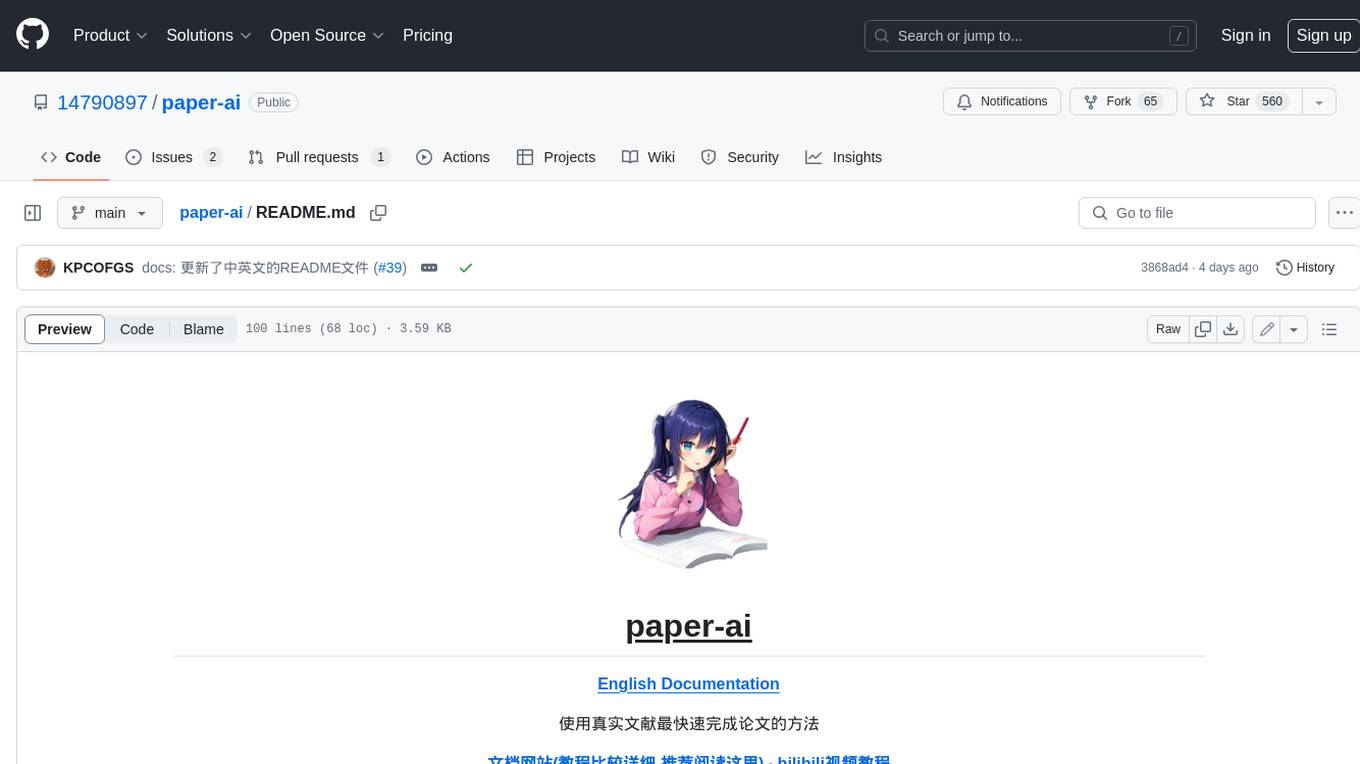
paper-ai
Paper-ai is a tool that helps you write papers using artificial intelligence. It provides features such as AI writing assistance, reference searching, and editing and formatting tools. With Paper-ai, you can quickly and easily create high-quality papers.
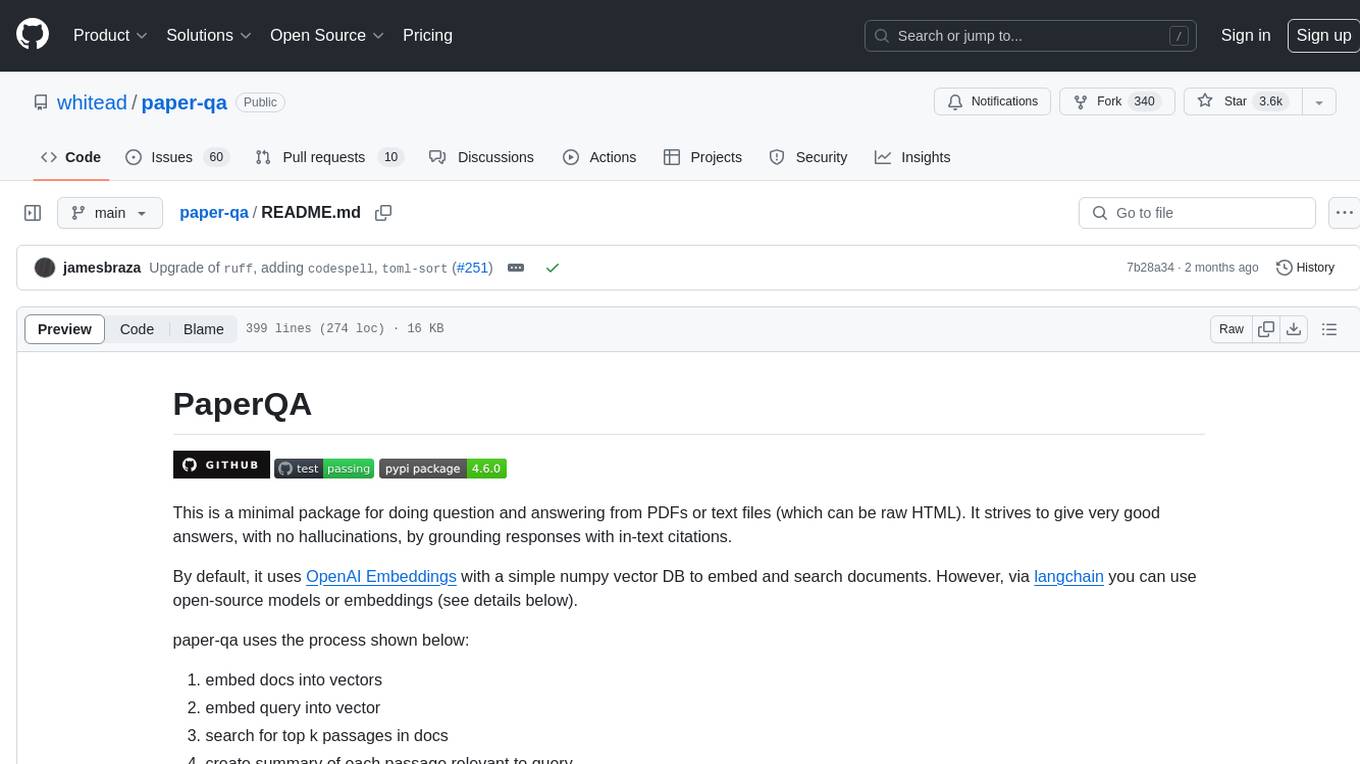
paper-qa
PaperQA is a minimal package for question and answering from PDFs or text files, providing very good answers with in-text citations. It uses OpenAI Embeddings to embed and search documents, and follows a process of embedding docs and queries, searching for top passages, creating summaries, scoring and selecting relevant summaries, putting summaries into prompt, and generating answers. Users can customize prompts and use various models for embeddings and LLMs. The tool can be used asynchronously and supports adding documents from paths, files, or URLs.
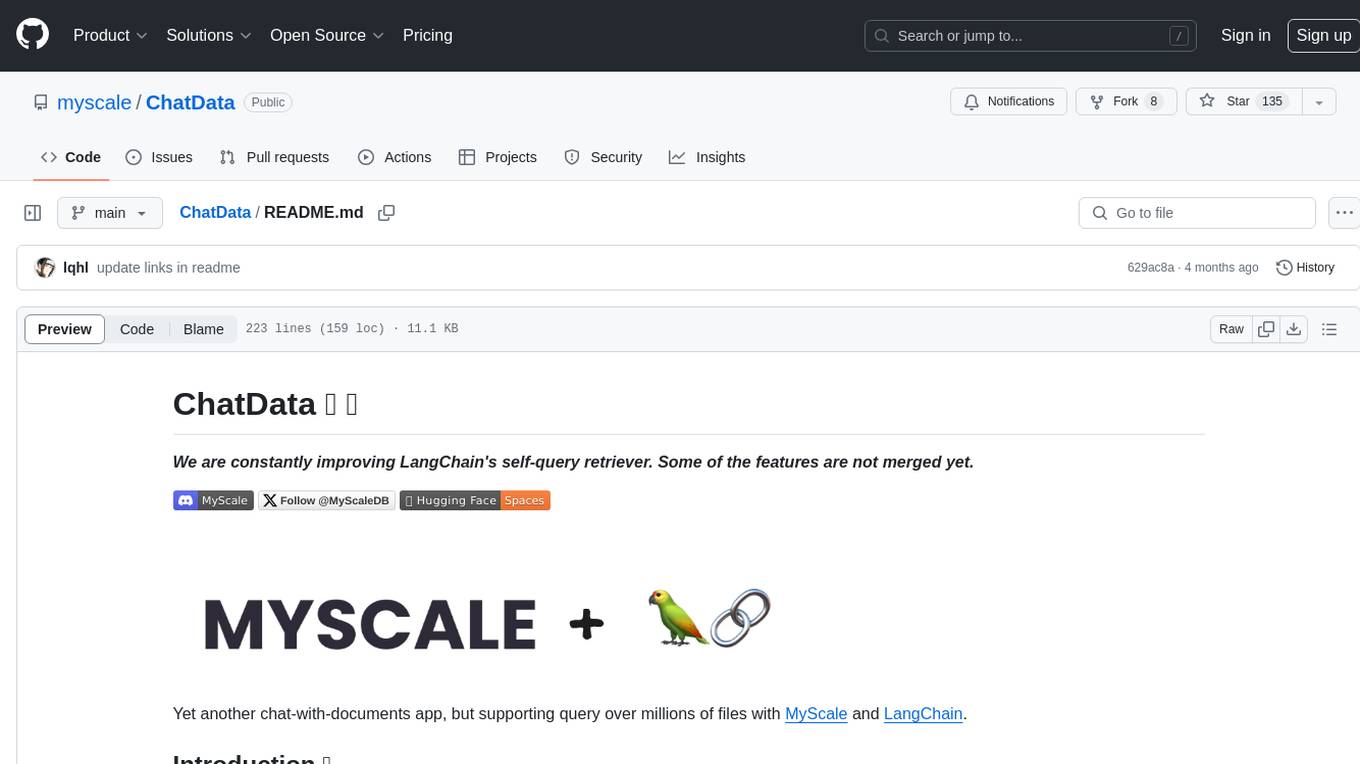
ChatData
ChatData is a robust chat-with-documents application designed to extract information and provide answers by querying the MyScale free knowledge base or uploaded documents. It leverages the Retrieval Augmented Generation (RAG) framework, millions of Wikipedia pages, and arXiv papers. Features include self-querying retriever, VectorSQL, session management, and building a personalized knowledge base. Users can effortlessly navigate vast data, explore academic papers, and research documents. ChatData empowers researchers, students, and knowledge enthusiasts to unlock the true potential of information retrieval.
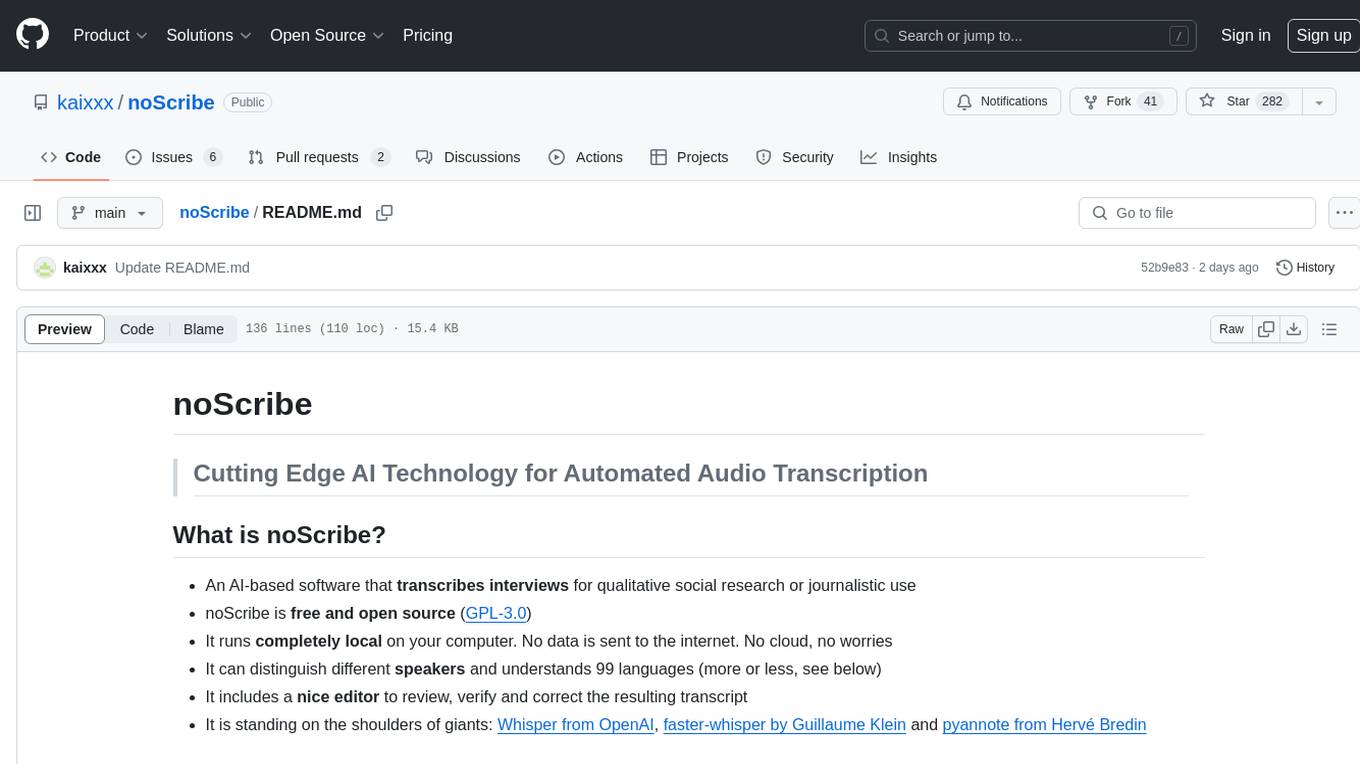
noScribe
noScribe is an AI-based software designed for automated audio transcription, specifically tailored for transcribing interviews for qualitative social research or journalistic purposes. It is a free and open-source tool that runs locally on the user's computer, ensuring data privacy. The software can differentiate between speakers and supports transcription in 99 languages. It includes a user-friendly editor for reviewing and correcting transcripts. Developed by Kai Dröge, a PhD in sociology with a background in computer science, noScribe aims to streamline the transcription process and enhance the efficiency of qualitative analysis.
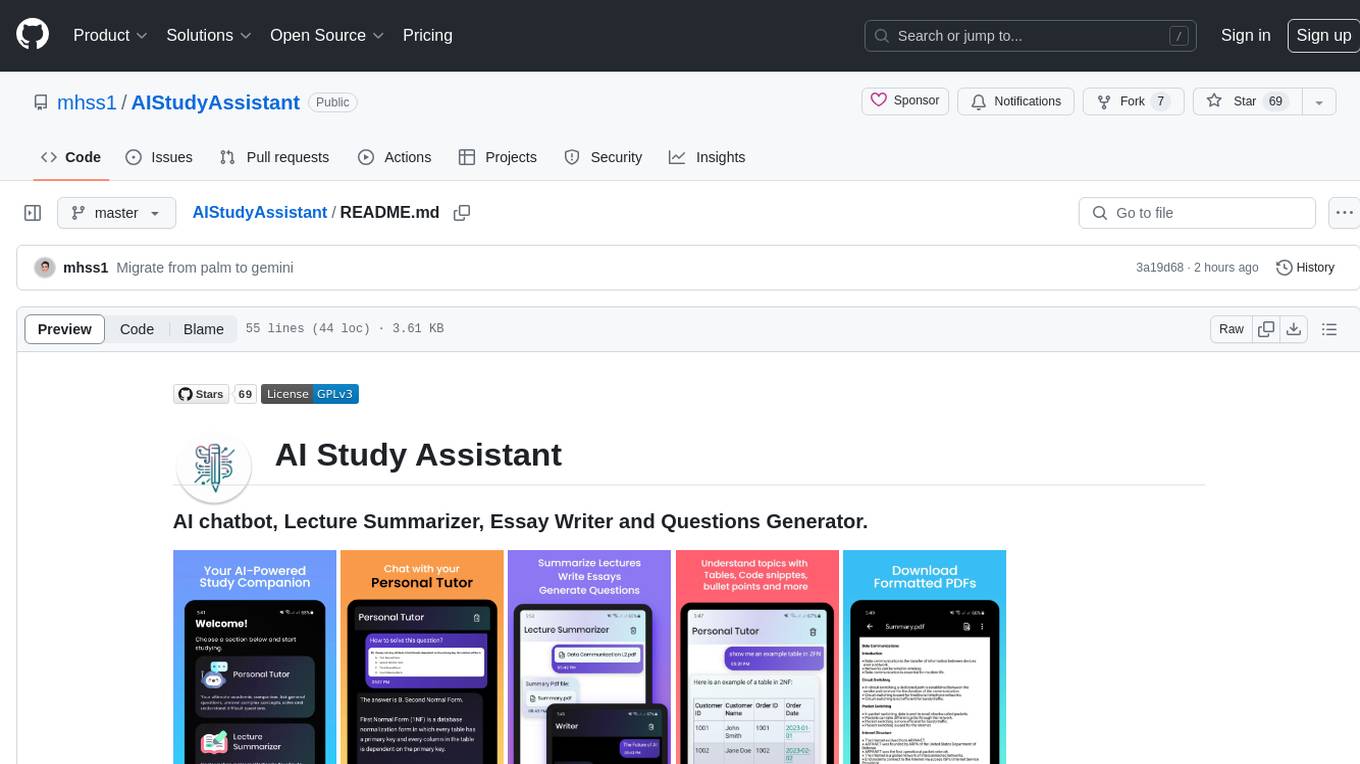
AIStudyAssistant
AI Study Assistant is an app designed to enhance learning experience and boost academic performance. It serves as a personal tutor, lecture summarizer, writer, and question generator powered by Google PaLM 2. Features include interacting with an AI chatbot, summarizing lectures, generating essays, and creating practice questions. The app is built using 100% Kotlin, Jetpack Compose, Clean Architecture, and MVVM design pattern, with technologies like Ktor, Room DB, Hilt, and Kotlin coroutines. AI Study Assistant aims to provide comprehensive AI-powered assistance for students in various academic tasks.
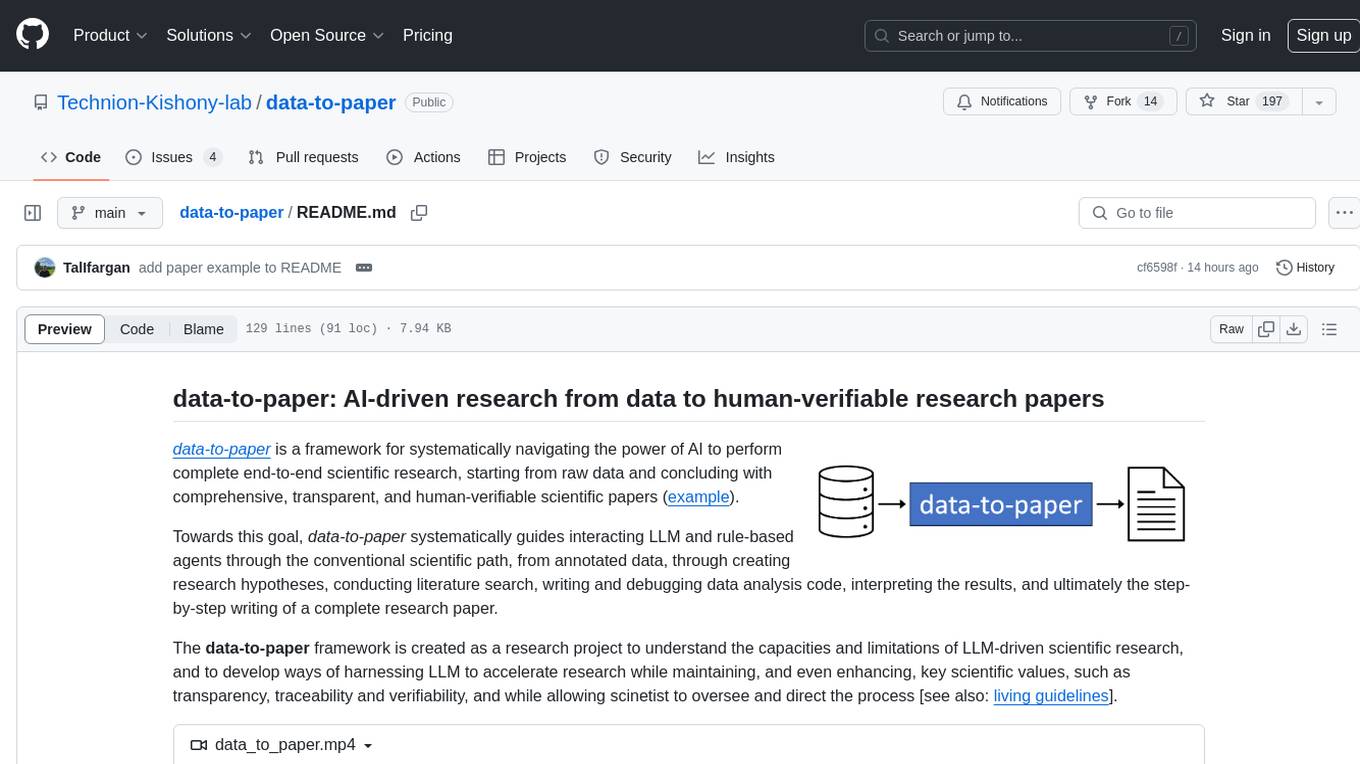
data-to-paper
Data-to-paper is an AI-driven framework designed to guide users through the process of conducting end-to-end scientific research, starting from raw data to the creation of comprehensive and human-verifiable research papers. The framework leverages a combination of LLM and rule-based agents to assist in tasks such as hypothesis generation, literature search, data analysis, result interpretation, and paper writing. It aims to accelerate research while maintaining key scientific values like transparency, traceability, and verifiability. The framework is field-agnostic, supports both open-goal and fixed-goal research, creates data-chained manuscripts, involves human-in-the-loop interaction, and allows for transparent replay of the research process.
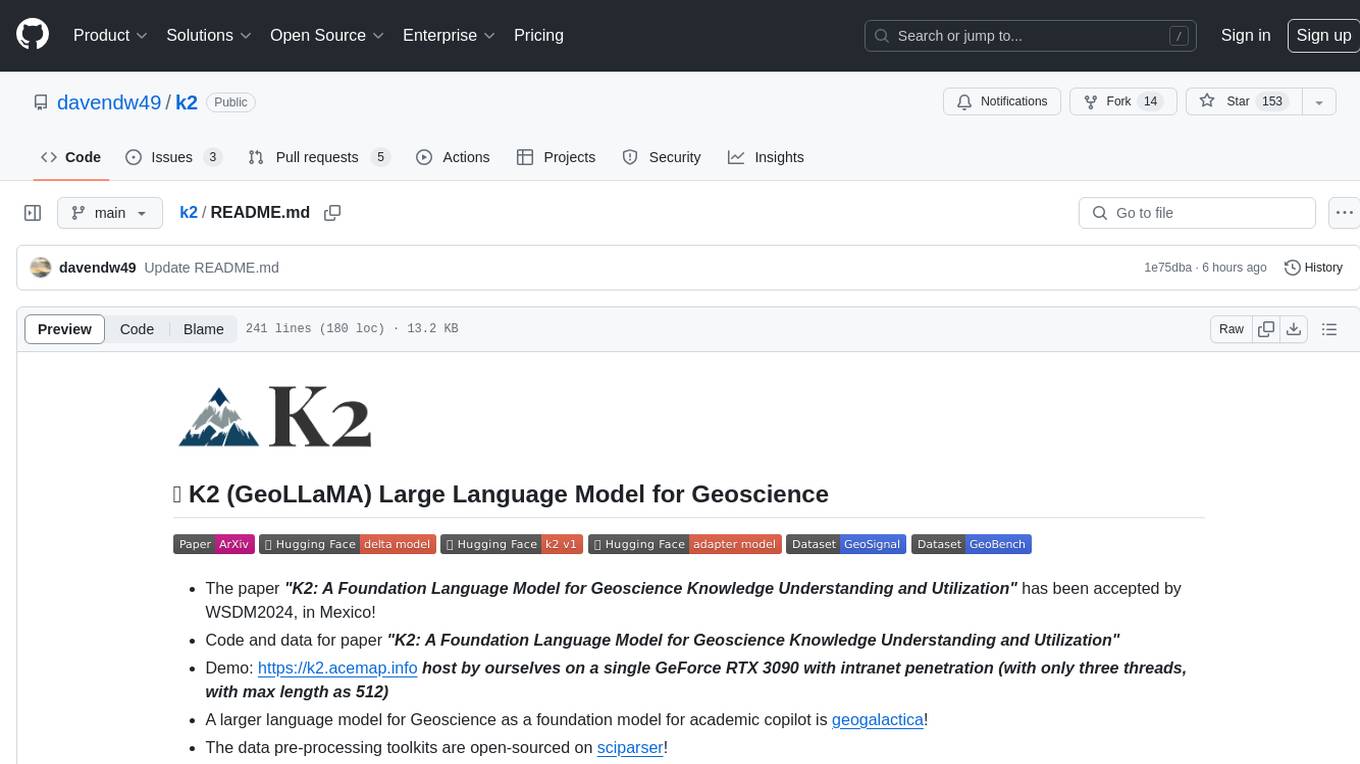
k2
K2 (GeoLLaMA) is a large language model for geoscience, trained on geoscience literature and fine-tuned with knowledge-intensive instruction data. It outperforms baseline models on objective and subjective tasks. The repository provides K2 weights, core data of GeoSignal, GeoBench benchmark, and code for further pretraining and instruction tuning. The model is available on Hugging Face for use. The project aims to create larger and more powerful geoscience language models in the future.